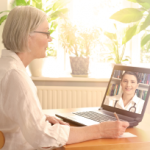In general, the rheumatologists that Mr. Kropp works with have found that for telemedicine to be a meaningful encounter in rheumatology requires specialized nursing support at the patient’s side. The physician’s concern lies in being unable to palpitate joints, consider range of motion and other critical information derived from a physical exam performed in person.
Tick Tock Doc
Dr. Daniel Albert, professor of medicine and pediatrics in rheumatology at Dartmouth College Geisel School of Medicine in Hanover, N.H., has used telemedicine in his practice for about three years. He has not seen the kiosk model in operation, but he notes that there are many possibilities and avenues for telemedicine and they all address fundamentally one thing—access.
“From a standpoint of patient care, getting patients seen in a timely fashion is very hard because you have to book schedules months in advance,” Dr. Albert tells The Rheumatologist. “Then you have very little flexibility for acute care and then when [patients] are booked way out like that, many of them don’t come because the problem has already resolved itself or they sought other care.”
Healthcare Evolves

Dr. Albert
Continuity of care is often a big concern with the use of any type of telemedicine, but one that proponents believe can be overcome. To ensure care continuity, information gathered during HealthSpot visits integrates with electronic records of a Cleveland Clinic patient, say company representatives.
“We built the HealthSpot platform to enable the medical community to extend their services and create new access to care sites that were consumer friendly and low overhead,” notes Steve Cashman, CEO of HealthSpot. “This retail health play by Cleveland Clinic with Marc’s [pharmacy] is a great example of how to evolve healthcare.”
Making Telemedicine Work in Rheumatology

Dr. Lisse
Dr. Jeffrey Lisse, professor of medicine, medical director of the University of Arizona Arthritis Center’s Osteoporosis Program and medical director of the Arizona Telemedicine Program, says the shortage of rheumatologists makes the kiosk model a “promising idea if the challenges can be overcome.
“The training and expertise of the provider with the patient will have a lot to do with how useful the encounter will be,” Dr. Lisse says.
Challenges include the fundamental examination that is performed to assess whether joints are swollen, inflamed or degenerative, which is difficult to do without actually touching the patient, says Dr. Lisse. Currently no devices exist that can be used to aid a physician examining a patient via telemedicine technology, he says.



